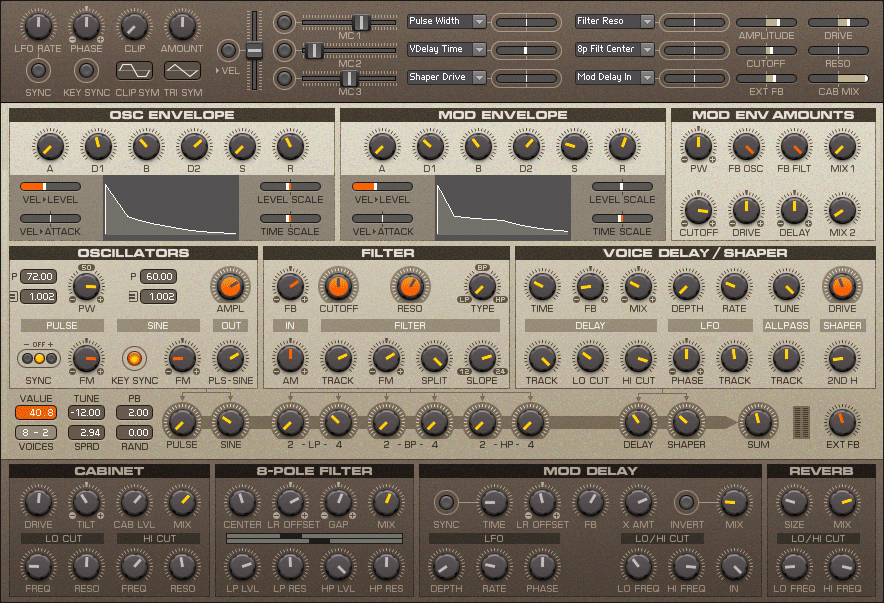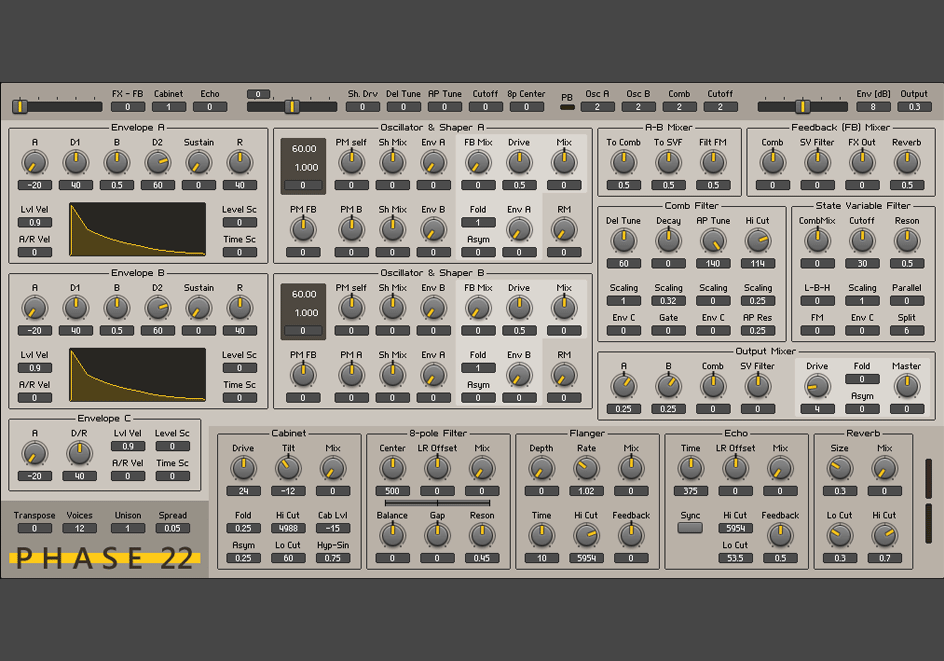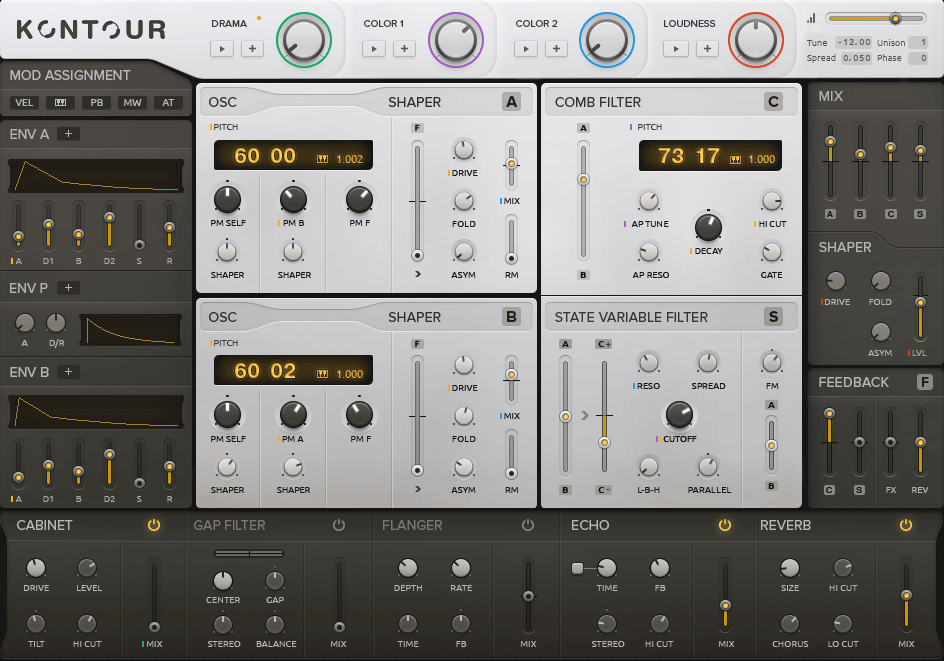Background
About FM and Chaos
(by Stephan Schmitt)
I have always been fascinated by FM synthesis (FM means frequency modulation but in reality, the technique used is phase modulation). John Chowning was the pioneer researcher in this field and Yamaha created the first commercially available instruments.
For a number of years - between the end of the 80's and beginning of the 90's - the Yamaha DX7-II was my main instrument. I also used several other DX/TX/TZ/SY/TG models. These instruments were based on simple building blocks but offered a vast potential for sound programming. The results were not easy to predict but worth the effort. One of their most important advantages was that they could be programmed to respond very expressively to key velocity.
The algorithms of the first FM synths already contained a feedback loop. Later, in NI's FM7 the algorithms were extended to a matrix where every operator's output signal can be sent to any operator's input, allowing even multiple feedback loops. In addition, all these signals can be mixed to the output. We also learned that a filter and a distortion operator make a lot of sense in such structures.
In an earlier stage of the Phase 22 project it was a 4-operator FM synth, but for more simplicity and focus the frequencies of two of the sine oscillators were set to 0 Hz, which means they became sine shapers.
An interesting lesson from "chaos theory" is that even a simple system can behave in a surprisingly complex or "chaotic" way. A good example is a filter with a propagation delay and a non-linear component combined in a feedback loop with enough gain. The non-linear stage could be a wave shaper, or an oscillator with an input for frequency, phase or pulse width modulation or for hard sync.
The design of Spark was inspired by the early Reaktor Ensemble Weedwacker which had a feedback from the output of the filter to the PWM input of the oscillator. Weedwacker fascinated many users because its simple structure was able to produce organic and chaotic sounds.
Synth Engine Evolution
Parts of the design of Phase 22 evolved from Spark and Cha-Osc and also benefit from the experiences designing Prism and Skanner, which are all Reaktor instruments developed at NI. As with Spark and Cha-Osc, the synthesizer uses very basic waveforms — in this case only two sine wave oscillators. But the concept behind Phase 22 is at the same time more radical and more consistent compared to its predecessors. The result is a very symmetrical structure with a core which is reminiscent of a two-operator FM synthesizer.
An earlier version of Phase 22 was the basis for the development of Native Instruments' Kontour in 2014. With the learnings from the Kontour project we have improved Phase 22 in many aspects, and it is still evolving as it becomes part of the C15.
The C15 Synth Engine compared to Kontour:
- Higher resolution for velocity, hardware controls and parameters.
- Six instead of four Macro Controls.
- Each of the Macro Controls can address around 185 parameters.
- Flexible mapping of ten modulation sources (Bender, Aftertouch, 4 Pedals, 4 Ribbons) to the six Macro Controls.
- The Oscillators got the Fluctuation feature providing a large variety of noise and random signals.
- Control over the Phase offsets of the Oscillators.
- Phase Reset option for the Oscillators.
- The new Chirp filter allows to control the bandwidth of the phase modulation.
- The Feedback Mixer got its own shaper for improved control of the feedback behaviour.
- Key tracking adjustable for the level of the feedback bus.
- The Feedback paths can be controlled by Envelope C.
- The Envelopes got adjustable Attack Curves.
- The Decay 1 segment of the Envelopes can work like a static "hold" segment.
- The Decay times of the Envelopes can be controlled by velocity.
- The Elevate parameter allows to set different Breakpoint and Sustain levels for amplitude and timbre.
- Envelope C is now ADBDSR with bipolar levels, loop option, and more destinations.
- The delay of the Comb Filter can be modulated by the Oscillators (similar to phase modulation).
- The State Variable Filter has been re-designed to be more effective and flexible in band-pass and band-reject modes.
- Stereo Pan for the Oscillators and Filters in the Output Mixer.
- Adjustable key tracking for the Stereo Pan of voices.
- Adjustable Stereo spreading of Unison voices.
- The Flanger is now in front of the Cabinet.
- The Flanger has been extended by a 4-pole Allpass for phaser-like response.
- The Flanger can be controlled by a key-triggered envelope.
- The Flanger's stereo LFO is available for Tremolo.
- The Cabinet is now a stereo effect.
- The Cabinet got more distortion and filter parameters.
- The Gap Filter now can also work as an 8-pole bandpass filter and offers adjustable resonances.
- More control over the stereo processing of Flanger and Echo.
- The Reverb is based on a vastly improved algorithm. Smooth transitions between different Sizes.
- Dual sounds provide Split and Layer modes, including editable zones for stacking and key-position fades.
- Two groups of five effects, which are available in parallel and serial mode for single and dual sounds.
- Oscillator and filter signals can be routed to the correspondig voice of the other part of a Layer sound.
- With dual sounds the output signal of a part can be input signal for the other part.
- Monophonic modes with adjustable Priority, Legato modes and Glide time.
- Extended parameter ranges.









